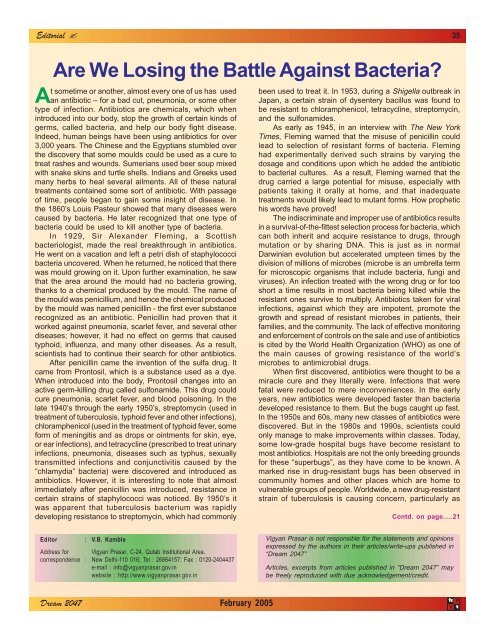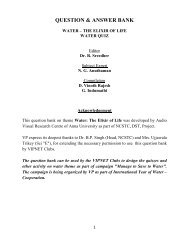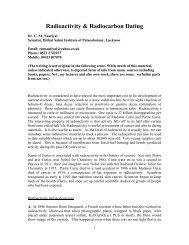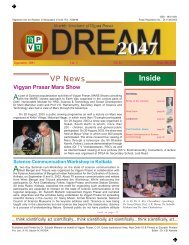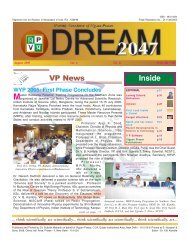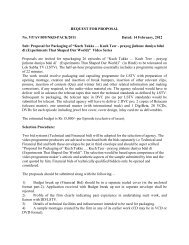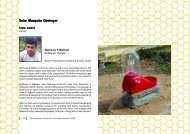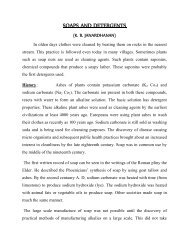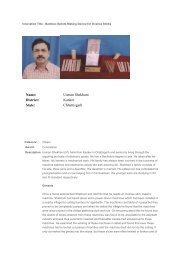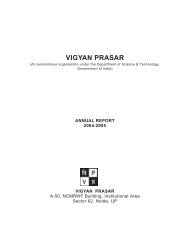Inside - Vigyan Prasar
Inside - Vigyan Prasar
Inside - Vigyan Prasar
You also want an ePaper? Increase the reach of your titles
YUMPU automatically turns print PDFs into web optimized ePapers that Google loves.
Editorial � 35<br />
Are We Losing the Battle Against Bacteria?<br />
At sometime or another, almost every one of us has used<br />
an antibiotic – for a bad cut, pneumonia, or some other<br />
type of infection. Antibiotics are chemicals, which when<br />
introduced into our body, stop the growth of certain kinds of<br />
germs, called bacteria, and help our body fight disease.<br />
Indeed, human beings have been using antibiotics for over<br />
3,000 years. The Chinese and the Egyptians stumbled over<br />
the discovery that some moulds could be used as a cure to<br />
treat rashes and wounds. Sumerians used beer soup mixed<br />
with snake skins and turtle shells. Indians and Greeks used<br />
many herbs to heal several ailments. All of these natural<br />
treatments contained some sort of antibiotic. With passage<br />
of time, people began to gain some insight of disease. In<br />
the 1860’s Louis Pasteur showed that many diseases were<br />
caused by bacteria. He later recognized that one type of<br />
bacteria could be used to kill another type of bacteria.<br />
In 1929, Sir Alexander Fleming, a Scottish<br />
bacteriologist, made the real breakthrough in antibiotics.<br />
He went on a vacation and left a petri dish of staphylococci<br />
bacteria uncovered. When he returned, he noticed that there<br />
was mould growing on it. Upon further examination, he saw<br />
that the area around the mould had no bacteria growing,<br />
thanks to a chemical produced by the mould. The name of<br />
the mould was penicillium, and hence the chemical produced<br />
by the mould was named penicillin - the first ever substance<br />
recognized as an antibiotic. Penicillin had proven that it<br />
worked against pneumonia, scarlet fever, and several other<br />
diseases; however, it had no effect on germs that caused<br />
typhoid, influenza, and many other diseases. As a result,<br />
scientists had to continue their search for other antibiotics.<br />
After penicillin came the invention of the sulfa drug. It<br />
came from Prontosil, which is a substance used as a dye.<br />
When introduced into the body, Prontosil changes into an<br />
active germ-killing drug called sulfonamide. This drug could<br />
cure pneumonia, scarlet fever, and blood poisoning. In the<br />
late 1940’s through the early 1950’s, streptomycin (used in<br />
treatment of tuberculosis, typhoid fever and other infections),<br />
chloramphenicol (used in the treatment of typhoid fever, some<br />
form of meningitis and as drops or ointments for skin, eye,<br />
or ear infections), and tetracycline (prescribed to treat urinary<br />
infections, pneumonia, diseases such as typhus, sexually<br />
transmitted infections and conjunctivitis caused by the<br />
“chlamydia” bacteria) were discovered and introduced as<br />
antibiotics. However, it is interesting to note that almost<br />
immediately after penicillin was introduced, resistance in<br />
certain strains of staphylococci was noticed. By 1950’s it<br />
was apparent that tuberculosis bacterium was rapidly<br />
developing resistance to streptomycin, which had commonly<br />
Editor : V.B. Kamble<br />
Address for <strong>Vigyan</strong> <strong>Prasar</strong>, C-24, Qutab Institutional Area,<br />
correspondence : New Delhi-110 016; Tel : 26864157; Fax : 0120-2404437<br />
e-mail : info@vigyanprasar.gov.in<br />
website : http://www.vigyanprasar.gov.in<br />
been used to treat it. In 1953, during a Shigella outbreak in<br />
Japan, a certain strain of dysentery bacillus was found to<br />
be resistant to chloramphenicol, tetracycline, streptomycin,<br />
and the sulfonamides.<br />
As early as 1945, in an interview with The New York<br />
Times, Fleming warned that the misuse of penicillin could<br />
lead to selection of resistant forms of bacteria. Fleming<br />
had experimentally derived such strains by varying the<br />
dosage and conditions upon which he added the antibiotic<br />
to bacterial cultures. As a result, Fleming warned that the<br />
drug carried a large potential for misuse, especially with<br />
patients taking it orally at home, and that inadequate<br />
treatments would likely lead to mutant forms. How prophetic<br />
his words have proved!<br />
The indiscriminate and improper use of antibiotics results<br />
in a survival-of-the-fittest selection process for bacteria, which<br />
can both inherit and acquire resistance to drugs, through<br />
mutation or by sharing DNA. This is just as in normal<br />
Darwinian evolution but accelerated umpteen times by the<br />
division of millions of microbes (microbe is an umbrella term<br />
for microscopic organisms that include bacteria, fungi and<br />
viruses). An infection treated with the wrong drug or for too<br />
short a time results in most bacteria being killed while the<br />
resistant ones survive to multiply. Antibiotics taken for viral<br />
infections, against which they are impotent, promote the<br />
growth and spread of resistant microbes in patients, their<br />
families, and the community. The lack of effective monitoring<br />
and enforcement of controls on the sale and use of antibiotics<br />
is cited by the World Health Organization (WHO) as one of<br />
the main causes of growing resistance of the world’s<br />
microbes to antimicrobial drugs.<br />
When first discovered, antibiotics were thought to be a<br />
miracle cure and they literally were. Infections that were<br />
fatal were reduced to mere inconveniences. In the early<br />
years, new antibiotics were developed faster than bacteria<br />
developed resistance to them. But the bugs caught up fast.<br />
In the 1950s and 60s, many new classes of antibiotics were<br />
discovered. But in the 1980s and 1990s, scientists could<br />
only manage to make improvements within classes. Today,<br />
some low-grade hospital bugs have become resistant to<br />
most antibiotics. Hospitals are not the only breeding grounds<br />
for these “superbugs”, as they have come to be known. A<br />
marked rise in drug-resistant bugs has been observed in<br />
community homes and other places which are home to<br />
vulnerable groups of people. Worldwide, a new drug-resistant<br />
strain of tuberculosis is causing concern, particularly as<br />
Contd. on page.....21<br />
<strong>Vigyan</strong> <strong>Prasar</strong> is not responsible for the statements and opinions<br />
expressed by the authors in their articles/write-ups published in<br />
“Dream 2047”<br />
Articles, excerpts from articles published in “Dream 2047” may<br />
be freely reproduced with due acknowledgement/credit.<br />
fo<br />
fo<br />
Dream 2047 February 2005 V<br />
P<br />
iz<br />
iz


